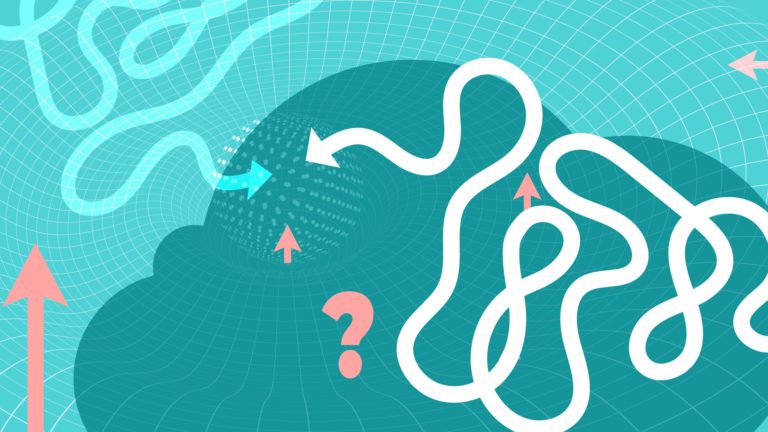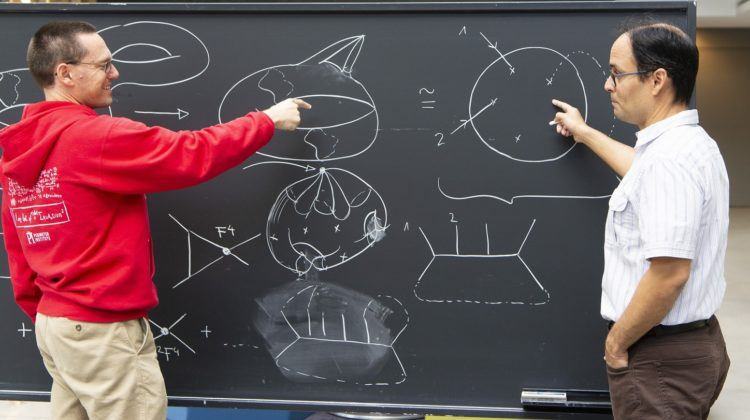Milestone on the road to quantum gravity
There are many roads that might lead to quantum gravity. Perimeter postdoc Benjamin Knorr has reached an important milestone on one of them: He’s calculated how matter scatters gravitationally.

“One of the big open problems in physics is the task of unifying gravity with quantum mechanics,” says Perimeter postdoc Benjamin Knorr.
That is an understatement. The fact that we have one universe described by two different theories is perhaps the largest, deepest, longest-standing problem in contemporary physics. The great minds of the field have been trying to map a way out of this problem for almost a century.
Nor is the disconnect between gravity and quantum mechanics a bit of existential dissatisfaction. Though the theories can be used separately, each in its own realm, there are places where both quantum effects and gravitational ones are important, and physicists need to use both theories at the same time. Black holes are one such place. The big bang is another.
Frustratingly, when both theories are needed, they refuse to work together. A straightforward combination of them produces nonsense: impossible infinities pop up throughout the calculations, math and ideas snarl up, and the whole theory becomes an impassible badland.
Like surveyors facing a mountain range, physicists have set out on many trails looking for the clear road to quantum gravity. Some of these trails have blazed further into the mountains than others. String theory, for instance, has many explorers, and they have found hints that they are on a productive track. Other approaches include loop quantum gravity, emergent gravity, shape dynamics, and asymptotic safety.
Modelling gravity with gravitons
One seemingly reasonable approach would be to treat gravity more like the three other forces. These forces are modelled via the exchange of force-carrying particles – photons for electromagnetism, W and Z bosons for the weak force, and gluons for the strong force. There’s even a hypothetical particle that would serve this role for gravity: the graviton.
“So that seems like a straightforward idea: model gravity with gravitons,” says Knorr. “But actually doing it turns out to be very, very hard.”

To figure out what happens when two or more particles interact – or scatter, in particle physics parlance – physicists use scattering amplitudes. You can think of a scattering amplitude as a list of everything that might happen in the interaction, with a probability assigned to each possibility. Scattering amplitudes are a basic tenet of particle physics – and therefore to any particle model of gravity.
Unfortunately, when physicists try to calculate the scattering amplitudes for gravitons, things fall apart. Gravitons have their own energy, which creates more warping of space, and thus more gravitons, which then create more warping, and more gravitons, until the table of possibilities piles up and spills out to infinities.
So calculating scattering amplitudes for gravitons is both crucial and difficult.
What should graviton scattering look like?
We don’t know what these scattering amplitudes should look like, but as Knorr says, there are a few key things we agree on. “One of them is causality,” he says. “No effect should come before its cause.” Another is unitarity – the idea that if you list all the possible outcomes of an experiment, they should sum to one, or unity. They shouldn’t be less than one, meaning that you’ve missed a possibility, or more than one, meaning that something is nonsensically more certain than certain.
So, this was the challenge that Knorr and his collaborators set for themselves: to calculate some scattering amplitudes involving gravitons that are causal and unitary.
“We picked a specific scattering process (essentially a simplification of a gravitational scattering of two Higgs particles) and derived the most general form of the scattering amplitude that doesn’t involve extra particles besides the graviton,” writes Knorr. “We were then able to show that one can formulate gravitational interactions in such a way that the scattering amplitude is causal and unitary.” What’s more, no unruly infinities spoiled the calculation.
They published the result in Physical Review Letters, with the cheeky title “Finite quantum gravity amplitudes – no strings attached.”
“To do this calculation in string theory you have to introduce a bunch of extra hypothetical particles – particles that we have looked for but never seen,” says Knorr. “There’s a principle in science that you should introduce as few assumptions as possible, so doing without these extra particles is very satisfying to me.”
He’s also pleased that their example calculation had only local interactions. “Local means that if you have a physical process on a lab on Earth, it is not influenced by what is happening in a faraway galaxy,” he says.
A milestone for asymptotically safe gravity
This approach has far-reaching implications for a path to quantum gravity called asymptotic safety. Like Knorr’s work, the asymptotic safety approach tries to frame quantum gravity by extending the ideas of particle physics.
“Our result shows that there must be certain relations between the gravitational interaction and the self-interactions of other particles for the theory to be unitary and causal,” writes Knorr. “Excitingly, such relations have been observed in the literature before, so that our result is another milestone for establishing the validity of the asymptotic safety approach to quantum gravity.”
In the wilderness between here and quantum gravity, asymptotic safety is not as well-blazed a trail as string theory or loop quantum gravity. But with this milestone, Knorr and collaborators show it is a promising one. They continue to explore.





















































































